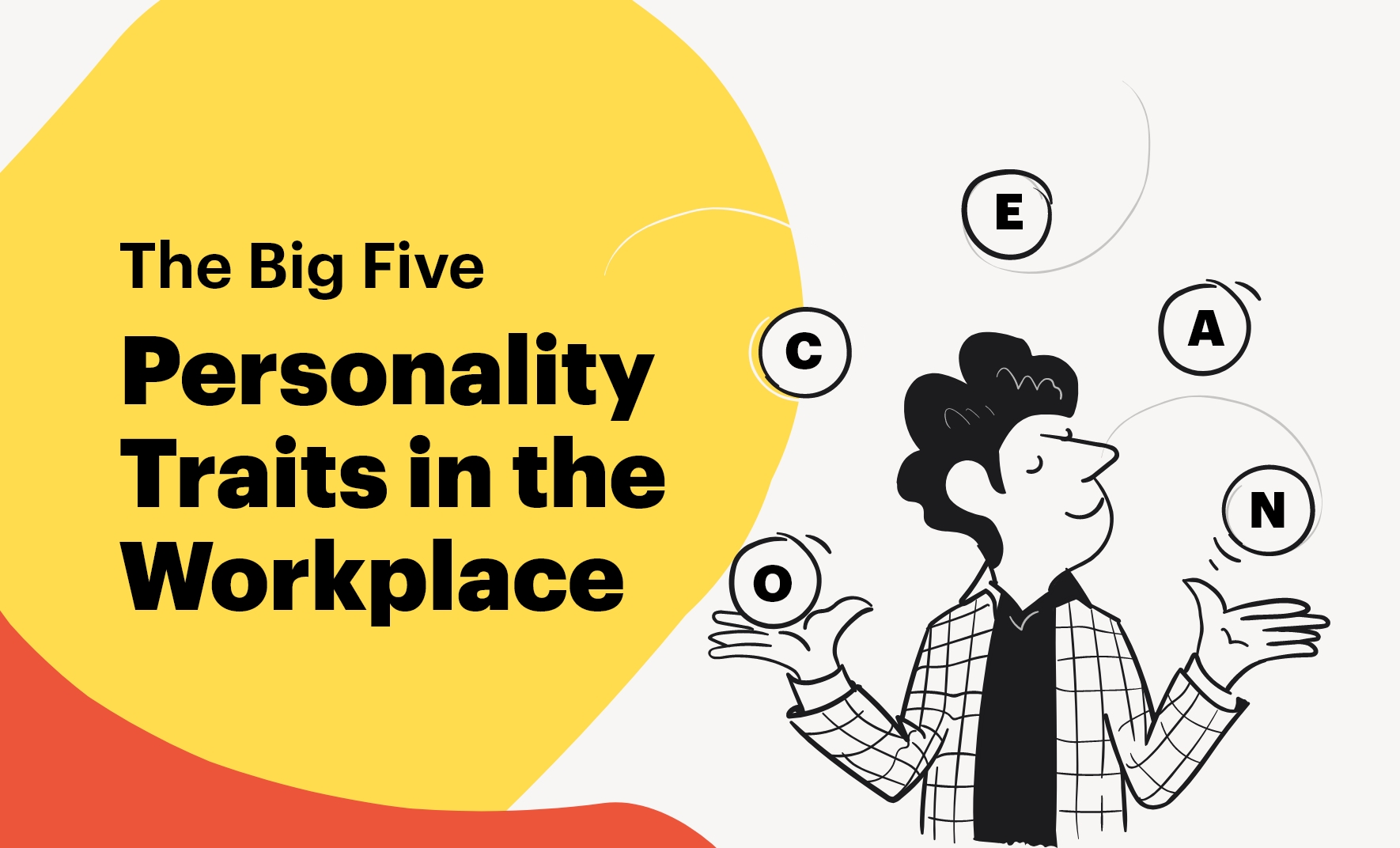The Big Five Personality Traits in the Workplace

What drives people to respond differently in situations has always been a topic for countless studies for psychologists. In the early 20th century, Swiss psychologist Carl Jung proposes a system of four main functions of consciousness modified by two attitude types: introversion and extraversion. In the meantime, Katharine Cook Briggs and her daughter Isabel Briggs Myers began research into personality. These studies and theories on the cognitive functions marked the beginning of psychological typology that developed into the well-known today Myers-Briggs Type theory (the MBTI), the Enneagram, the Socionics, and the Big Five personality traits.
Many studies with one purpose: to group different personality types based on how their cognitive functions work. And to understand how each type perceives the world and makes decisions.
What are the Big Five Personality Traits?
Understanding how different types of people think and make decisions is a huge advantage. Unfortunately, theories that explain the diversity of human personality with a small number of types are still not developed to be precise enough for measuring people’s personalities. Because of it, typology is often considered by psychologists as pseudoscience. Instead, they recommend broader trait models. Such is the five-factor model that human resources professionals adopt in their work.
The BIG Five personality traits have a handy acronym to help you place them.
OCEAN
O – openness to experience
C – conscientiousness
E – extroversion
A – agreeableness
N – neuroticism
It all sounds a bit forced, maybe too good to be true, to fit a lovely acronym system. But there is science behind the idea and plenty of it. Since the 1990s, the idea that personality can be split up into these 5 basic categories has become a driving force when studying human behavior. It is the biggest and most commonly used test in personality psychology. The question is what factors of our personality influence our behavior at home or at work and how can the knowledge of this then affect our selection and management of employees, assigning roles, promotion, team selection, employee motivation and engagement, and other areas of your business. Can the theory really make a difference? The answer is yes.
Testing the Personality Traits

The big five personality traits are tested by answering a series of questions. You are then given a score for each individual trait. The test consists of a series of statements that you rate on how true they are about you on a five-point scale where 1 = Strongly Disagree, 2 = Disagree, 3 = Neutral, 4 = Agree, and 5 = Strongly agree. You are also given a percentile score to indicate the number of people who have taken the test who are lower than you, as a percentage. There are numerous versions of the test available including free online versions. In such a test the honestly of the candidate is a prerequisite as indeed in a certain knowledge of themselves.
Hiring and Managing Talent

For a long time, it was assumed that intelligence tests and academic qualifications were the main focus when taking on new employees. Times are changing. Whilst these factors do have a bearing and shouldn’t be underestimated are they the most important traits? For certain jobs and roles having are ready-made skillset of the tasks required and the qualifications to prove it might be important. Employees need the basics. But more and more businesses are looking at the personality of the potential employee rather than the certificates they have amassed. This is particularly true in the dynamic fields of communications and technology, where qualifications can quickly become out of date and businesses have their own specific standards and methodology. In these cases, it is often more efficient to hire someone with the soft skills and willingness, and motivation to learn and be flexible rather than someone with a ready-made outlook.
Why You Need to Know the Traits
For this reason, a knowledge, or at the very least an awareness of the big five personality traits can be an enormous advantage for a CEO, HR team, and managers when not only choosing who to employ but also realizing how to get the best out of your workforce. Intelligence does not necessarily make the best team member, qualifications do not always go hand-in-hand with hard work or loyalty. How far does a CV really illustrate the creativity you may be looking for?
The big five personality traits help you to understand workers’ personalities. And if you can understand the character then as a manager you should be able to motivate, to encourage, to engage, to plan the type of work and work structure that will produce the best results, to select teams and strategies. This is even more crucial given that teams and workers are often not based in one place. Remote teams and workers still require managing but you don’t have the same physical access and cues to pick up on. Personality tests can play a vital role in gaining the information you need to effectively do your job.
What Do We Mean By…..
O – Openness to Experience
Trying new things, using your imagination, being creative and having artistic tendencies, open to new experiences, adventurous, open-minded -these are the traits that we are referring to in the O of our OCEAN. These factors may be ideal for some jobs especially in the creative arts and world of design. However, these traits are not ideal for work such as civil service, office work, or even sales.
High Scorers
- Curious
- Emotionally Open
- Creative and artistic
- Imaginative
- Liberal minded
- Push Boundaries
- Enjoy problem solving
- Challenge conventions
Low Scorers
- Factual
- Don’t like change
- Enjoy routines
- Need security and stability
- Less open emotionally
- Conservative with a small c
C – Conscientiousness
Reliability and dependability. Conscientious workers are goal orientated, they enjoy planning and feel the need for organization. Often hard work working, they have a determination and persistence and enjoy progress toward the final goal. These personality types can be the backbone of your business, they get things done and work to the best of their ability. However, they can also be seen as dry, lacking the creative spark and sense of energy that inspires a team.
High Scorers
- Goal and achievement orientated
- Well organized
- Self-disciplined and self-motivated
- Enjoys routines, schedules, and deadlines
- Careful, especially in decision making
- Have a sense of obligation to the project and the business
- Can be seen as perfectionists
Low Scorers
- Disorganized
- Sometimes unreliable
- Rash, especially in decision making
- Impulsive
- Highly social but easily distracted
E – Extroversion
Extroversion is the Big five scale is about how social and talkative a person is. Socially confident people who enjoy interacting with others, often energetic and positive. The opposite spectrum would be the introverted, quiet type. A person who likes solitude and enjoys their own company and is less keen on social situations. Whilst it might be useful to have extroverts on your team to keep the spirits high, too many can lead to fierce competition and even factionalism.
High Scorers
- Friendly
- Enjoys groups and social situations
- Energetic, lively, especially in social situations
- Like to direct others and be in charge
- Positive, optimistic
- Can be easily bored and quick to lose interest
Low Scorers
- Quiet, can be seen as unfriendly
- Reserved
- Prefer to be led than lead
- Happy to spend time alone
- Independent
A – Agreeableness
To be agreeable is to have the ability to get on with others. High scorers are often empathetic, sympathetic, cooperative, and people who enjoy collaboration. Their prime focus is group harmony rather than any individualness, and they are always open to compromise. Workers like this can often be the glue that holds the team together but they are unlikely to be a driving force for forward-thinking decisions.
High Scorers
- Sympathetic
- Likable
- Cooperative and collaborative
- Trusting and trustworthy
- Open to compromise
- Value the team more than the individual
Low Scorers
- Objective
- Honest, sometimes to the point of rudeness
- Can be intimidating and blunt
- Can be arrogant
N – Neuroticism
A dramatic term ( but it fits the acronym) Neuroticism might be better described as emotional stability and control. This trait measures emotional reactions and reactivity, anxiety, stress, and moodiness. How a person copes in a stressful situation and the effect on things like decision making and group mood is something to be aware of when choosing your team
High Scorers
- Anxious
- Stressful situations cause panic
- Moody
- Short-termism
- Easily discouraged
- Bad Tempered
Low Scorers
- Calm and even-tempered
- Confident
- Clear-thinking
- Long-termism
- Stability
In the Workplace
How these traits affect employees’ ability to do a job, perform a task and contribute to the workplace culture is important. We need to factor in work performance and social behavior.
Work Performance
C
Generally, the trait of conscientiousness has the biggest influence on work performance. High scorers in this area are not only knowledgeable but they see constant learning and self-improvement as vital to their success. They have the self-motivation and ambition to succeed even in demanding tasks. Their focus and determination often make them ideal employees and good leaders especially in fields of work where there is a great deal of routine. They are also loyal employees and more likely to stay with the business long-term. In addition, they are ideal for remote work, functionally independently and efficiently.
A
Agreeableness ranks highly in the workplace too. The idea of teams and more and more collaborative working means that a willingness to work with others towards a successful outcome is essential. Agreeableness is the behavior and attitude to work with others, tolerate differences and try your hardest to keep everyone together. This is more than just a great component to have in teammates, it is an important factor for managers and leaders who need to interact with employees in a more open and inclusive way. High scorers in agreeableness usually have a high job satisfaction rating too, meaning that they are likely to be long-term employees.
E
A high score on extroversion can signify someone who feels comfortable when in charge and as such may feel comfortable as a team leader or in a management role. Their positive attitude can drag people along with them and they often have strong task performance levels. However, this has to be balanced by their tendency to be impulsive and distracted.
O
Openness can be a really useful component of your staff member. Their adaptability and creative thinking make them good employees, especially in creative industries. They are also suitable for positions of responsibility, taking things in their stride and being able to think outside the box and form problem-solving strategies rather than being thrown off course.
N
A high score in Neuroticism would suggest that these characters are harder to manage. Ideally, you would be looking for a lower score in this category indicating a calmer more emotionally stable employee. This doesn’t mean a high score in this area should be an automatic no. The plus of this Big five system is that you know who you are dealing with and what situations they can and can’t deal with.
Leaders Using the Big Five Personality Traits
The science behind the big five test is pretty emphatic and has been shown to be accurate in most countries of the world. However, we are humans so no one is going to fit into a perfect pattern and take on the exact role allocated by the test in all situations, at all times. There are always going to be other factors at play, including external social factors.
What is important is for leaders to understand the big five personality test is a guide to help improve understanding of types. this understanding is not for its own sake, it is for leaders to use to improve their own understanding and leadership effectiveness which in turn should help the employee’s performance, productivity, and job satisfaction. Using this information you can adapt your motivational methods, assign different roles, create effective multidimensional teams, improve cohesion and coordination. You can work with your team as individuals knowing what makes them tick, what stresses them out.
And of course, leaders can use the Big Five personality test to self-assess. To look at your own areas of weakness and work towards improvement.
Conclusion
Team building, motivation, engagement, effective management, workplace culture, employee retention, and satisfaction. All vital elements of a successful business. the big five personality trait test is not a magic wand, that suddenly creates a harmonious synchronized group from a disparate set of individuals. It is in fact another tool in your management box of tricks. It allows insight and understanding of the different characters that will inevitably make up your workforce. And like all tools, it will only help if you know how to use it properly.